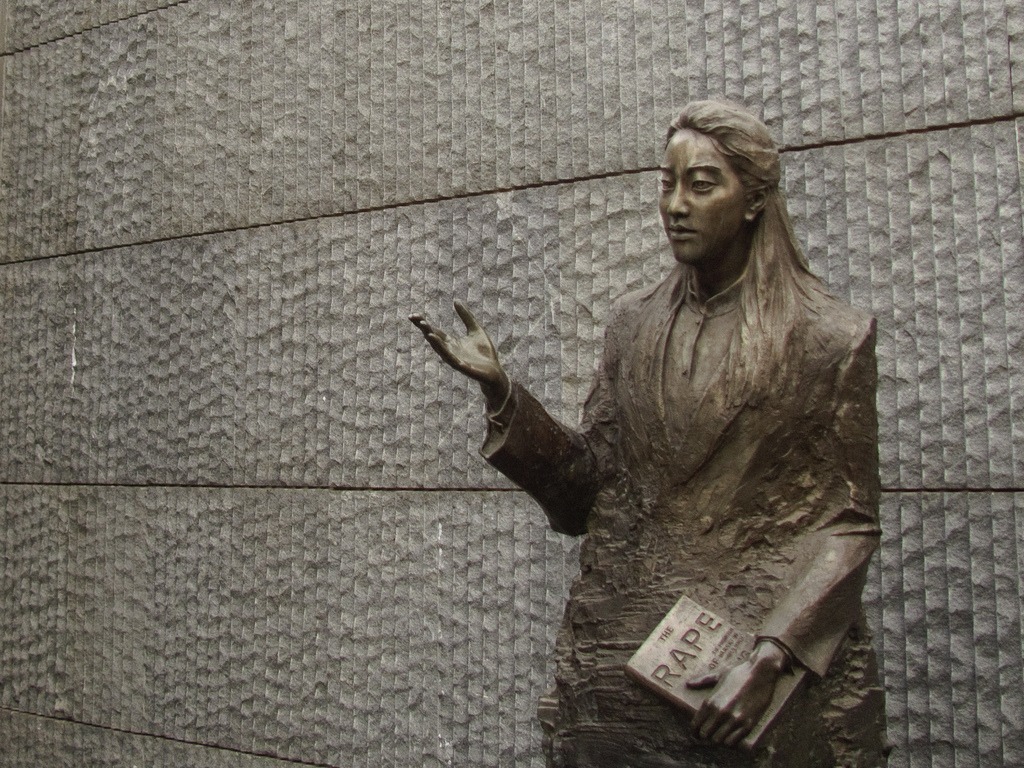On the Trail of Iris Chang

By Lisa Yin Zhang
Staff Writer
10/9/2019

Bronze statue of Iris Chang at the Nanjing Massacre Memorial Hall in Nanjing
The pithy version, the popular version, goes something like this: Iris Chang, a young, pretty, Chinese-American author, exposed the Western world to the atrocities of the Nanking Massacre in The Rape of Nanking. Haunted by visions of that horror, plagued by accusations over the historical inaccuracies in the book, and increasingly paranoid about being bugged and followed, Iris took her own life at the age of 36. She was, according to some, the final victim of the Nanking Massacre.
Iris was born in 1968 in Princeton, New Jersey, the daughter of two academics who had emigrated from Taiwan. She moved, at a young age, to Illinois, where she quickly developed a love of reading and writing. As a college student at the University of Illinois at Urbana-Champaign, she worked as a campus stringer for both the New York Times and the Chicago Tribune, interned at Newsweek, and edited the campus magazine. She got her first book deal, incredibly, just two years later, while completing a master’s degree at Johns Hopkins. The Thread of the Silkworm, published in 1995, tells the story of Hsue-shen Tsien, a Chinese scientist crucial to the development of jet propulsion technology in the United States before being suddenly and unceremoniously expelled during the Red Scare, whereupon he returned to China to develop the Silkworm missile.
Her next book, the infamous The Rape of Nanking: The Forgotten Holocaust of World War II, was the first English-language book on a subject then widely unknown in the west: the murder, torture, and rape of hundreds of thousands of Chinese civilians during the Sino-Japanese war. The book was critically-acclaimed, enormously popular, yet also controversial, with both rightwing Japanese groups and select historians denouncing it as inaccurate. Iris would receive death threats related to The Rape of Nanking through the release of her next book, The Chinese in America, and until the end of her life. While working on her last manuscript, on the Bataan Death March, Iris became increasingly paranoid, believing that she was being followed, that someone had tailored the TV channels in a motel specifically to frighten her. She suffered a nervous breakdown. She was prescribed a string of medications that only seemed to make things worse. On November 9th, 2004, Iris pulled over to the side of a road, stuck a gun in her mouth, and pulled the trigger.
On November 9th, 2004, Iris pulled over to the side of a road, stuck a gun in her mouth, and pulled the trigger.
Iris led an incredibly successful life. She met with presidents, went on talk shows, packed any auditorium, riveted any audience. She was prodigious, incandescent — burning bright, burning out.
But it’s not just that that sparked my obsession with her. It was that a young Iris hated pre-school, the stress of which made suck her fingers, wake in the middle of the night. It was that she developed a speech disorder, that she loved cats, had adopted a stray kitten and fed her slivers of meat she had hidden and saved from her own meals. That she was precocious: at nine, she entered a series of poems into a competition that won her school competition, then the local competition, then the regional once. That she was, unsurprisingly, a bookworm, reading voraciously by the light of a cracked door deep into the night, unable to wake for school in the morning. That she played the piano; that she thought herself ugly, but wasn’t.
I can envision so precisely the type of kid Iris was because I knew that kid, because I detested that kid, and because, in many ways, I was that kid. I arrived in New York as a four-year-old, freshly unprepared for the labors of pre-kindergarten life, shafted into a local pre-school with no English. Then the teacher pulled my mother aside, told her I was gifted. The unsurprising ensued: I tested into magnet schools, ruined my eyes reading under covers, won an art competition with a drawing of ice cream, got ugly braces and thick glasses. I became preternaturally competitive, resentful of the girl who was a faster reader, whose hand shot up faster, whom the teachers seemed to fawn over. I loved cats and begged for one incessantly. I played Für Elise and Moonlight Sonata, those staples of early pianohood. I developed what seemed to be a speech disorder.
On the face of it, the affinity of our lives are merely incidental. But something about the life of Iris Chang has my ear pitched like a paranoiac to allusion, to recursion, to coincidence. I could not — cannot — shake the sense that she carved the path, inch by harrowing inch, that I, another Asian-American writer, now tread with unearned ease. Iris wrote The Rape of Nanking, the book for which she is famous, in 1997, the year I was born. The story of that massacre haunted her young life, much the way her own life story has haunted mine.
Iris carved the path, inch by harrowing inch, that I, another Asian-American writer, now tread with unearned ease.
I officially learned about the Rape of Nanking in middle school, though the words might have floated through my household the same way the name “Iris Chang” had. Curious, and born in a different time, she went to the library to learn more about the massacre, but found nothing: “I couldn’t find a shred of information on the subject,” she wrote. “There was nothing in my local school libraries, or my public city libraries, or in my world history textbooks.” This was in stark contrast to my own experience — precisely because of the work Iris had done. The name of the textbook eludes me now, but the images, spanning multiple pages in full-color, do not. And I remember another image still, the small shock that sent through my system as I opened Iris’s Wikipedia page, looked upon her face — those wide, earnest, double-lidded eyes, the bushy bangs fashionable in that era in which she was frozen — and thought: You look just like my mother.
I asked my parents, recently, “What did you guys think when The Rape of Nanking came out?” knowing that it had made big waves amongst the Asian diaspora, that it had come as such relief for so many who needed that history told, that my grandpa himself had come of age in Japanese-occupied territory. “Came out the year you were born,” my dad said, unhelpfully. My mother said — a phrase I’d never heard her use, didn’t even know was in her arsenal — “Let bygones be bygones.”
My mother had that pioneer mindset, distinctly American: keep moving forward — and don’t you dare look back. I could see why Salt Lake City appealed to her, that land of the Mormons, a persecuted people who marched across the continent with all their belongings on their backs to make their own history, to carve a life out of a basin of salt.

Salt Lake City (Picture Credit: Garrett)
In 1990, pioneers themselves, my mother and father arrived in this part of the country, newlywed. On weekends, on holidays, they took trips to national parks to explore the sublime American landscape. My father had just procured his license and drove a used car down the steep and winding mountain roads as the sun set, gripping the wheel with white knuckles.
It seemed the rite of passage for a young, Chinese couple. Fifty years before on the dot, in the summer of ’69, Ying-ying and Shau-Jin Chang would have taken the same route with a toddler-aged Iris in tow. “I secretly wished that we could live in this beautiful part of the country for the rest of our lives,” Iris’ mother Ying-ying wrote, seeming to savor the moment. My own mother would have said the same.
Recently, we retraced their route, taking a train west from Chicago, coursing through the plains of the Midwest, through the Rockies and Sierra Nevadas, through Salt Lake City, through Reno, and ending, finally, in San Francisco, that first booming Chinatown of the United States. Before settling in New York, home of the other great American Chinatown, my parents had bounded from Galveston, Texas, to Salt Lake City, Utah, to Orlando, Florida, zipping back and forth on an American Airlines student pass. My mother explained this to me as we sat in the dining car, cloth napkins on our laps, looking out over a vista of pines on one side and a precipitous drop on the other. We sat on a train called the California Zephyr, slipping easily through the rugged landscape.

Picture Credit: Loco Steve
But a name like “zephyr” — a breeze, a waft, a gentle wind from the west — belies the human labor and historic cost of this journey, much of it built on the backs of the Chinese, many of whom lie buried in the rubble beneath this picturesque route. Where now we sped frictionlessly along, people like us had chiseled tunnels with nothing but handheld drills and shovels. While we traversed full states in mere hours, they had encountered porphyritic rock so tough that work proceeded an average of seven inches per day. “History does not record how many Chinese men, reduced to the level of human machinery, died from accidents or disease,” wrote Iris.
We stopped in Jackson Hole, Wyoming, with the rest of the American elite who summered in the sleepy town, hiking and camping out in the wilderness. We drank beer out on picnic tables and ate barbecue dripping with fat as a band set up beside us to play a set at dusk. We floated on a big blue raft down the Snake River, our tan tour guide jokingly threatening to row us toward whitewater, while I tried at once to summon and repress the image of 31 Chinese miners shot, mutilated, thrown in this very river in 1887 by white men intent on stealing gold.

Snake River Canyon, Idaho
I thought about what we were looking for out here, my family and I, scoping out our old baby-blue house, retracing the steps of our own history. I thought about the jup seen you trips (“retrieving old friends”) Chinese railroad workers would embark on years after the last spike was laid. “Digging underneath the stones,” Iris wrote, “they would find a skeleton next to a wax-sealed bottle, holding a strip of cloth inscribed with the worker’s name, birth date, and district of origin.” Sometimes there wasn’t even that.
I thought that the name of Iris Chang was staked on the history of this land even if it wasn’t sealed up in a bottle. That that bitter refrain across each of her books — “History does not record…” — is itself not only an indictment of history but a form of historiography itself.
“This book was written with George Santayana’s immortal warning in mind,” Iris wrote in The Rape of Nanking. “Those who cannot remember the past are condemned to repeat it [italics hers].” And she wrote, in the preface to The Chinese in America:
I couldn’t let go of the idea of exploring the history of my people…I believed I had a personal obligation to write an honest history…to dispel the offensive stereotypes that had long permeated the US news and entertainment media…The lack of strong Chinese American role models in popular culture — or even of realistic images of Chinese Americans as diverse and multifaceted human beings — bothered me deeply. People tend to perform at a level society expects of them, not their actual potential, and I imagined there must have been many young Americans of Asian descent who suffered a crisis of confidence as a result of coming to see themselves as they thought others saw them.
“Iris ended up writing three books in her short life,” Ying-ying Chang wrote in The Woman Who Could Not Forget: Iris Chang Before and Beyond the Rape of Nanking, a memoir of her daughter, “that were all related to China.” She pointed out that Iris’s first book, The Thread of the Silkworm, was actually written on an editor’s suggestion — she had initially wanted instead to write a biography about a white American physicist. But the subjects of her next — and last — two books were her choice alone.
Iris was excited and articulate on an astounding range of subjects: “Every day, I think of a new idea for a book,” she wrote her mother in a letter. “For instance, the history of commuting in the United States…To find the heart of our national soul, as many writers seek, we must start with the web of arteries that we call our highways.” Yet somehow, she ended up writing almost entirely on the subject of Chineseness.
I don’t think Iris ever set out to write solely about the Chinese, Chinese-American, and Asian-American experience. I think, though, that she felt a strong obligation to tell their stories simply because no one else was doing so, because the lives of these people to whom she felt an affinity would otherwise go unrecorded. By a tenuous connection, a mental manipulation — she an American of Chinese descent, they Chinese workers in America — and an act of empathy, she assumed the responsibility for that monumental task.
And tell their stories she did. Her writing was powered by an uncanny ability to extend herself into an archive of tattered, disarrayed, or disappeared documents, to write animatedly about the long-dead. She made it her life’s work to look backwards. In her fixation on the past, did she realize the legacy she would leave in the future, the impact she would have? She became for me the Chinese-American role model she herself found lacking; she set the bar for how I believed — expected, even — myself to perform. She bore a burden for me, for us, for any Asian-American who writes about Asian-Americanness — in fact, for any Asian-American who writes at all.
Her writing was powered by an uncanny ability to write animatedly about the long-dead.
And so each detail of Iris’s life has taken on poignancy, riven itself deep into my subconscious and imagination. But while I always saw in us an eerie similarity, those perceived similarities were perhaps little more than a series of coincidences, or else the result of a similar cultural heritage. Asian parents raise their children with the same principles and accoutrements to the point of trope: being a precocious Chinese-American who played piano, wore braces, and thought herself special marks me only as extraordinarily ordinary.
There is perhaps another reason Iris’ life has so resonated with me: who else? There was simply no other. When I told my father I considered becoming a writer, he stiffened. I thought at first he would sing that classic tune of the Asian-American father: Why not a doctor? Why not a lawyer? But he said, instead: “Have you heard of Iris Chang?”, forgetting that I must have heard her name first from his mouth. Like Iris’ parents, he was unusually supportive of the writer’s path for his child. But unlike Iris’ parents, he had somebody to look to in Iris, an example life — he recognized its value even if he did not like how it ended.
“The best way to control how history is written,” Iris wrote, talking about herself this time, “is to 1) be a compulsive letter writer, or 2) outlive your enemies.” She did at least the former, and it is through those letters that we know what Iris thought about, cared about, dreamed about that she hadn’t yet put into a book, busy as she was. It’s particularly gratifying, given the corpus for which she is known, to listen to her meditate on pleasure itself, to listen in on the moments of her life that were as low-stakes as she ever got to live. And it is fitting to give her the last word:
When the waves washed over the shore, it made a delicious seething sound, hissing as it sucked greedily at our toes, then pulling back and smoothing the surface of the sand until it was shiny and flat as a mirror. The sand was warm under your feet and with each step the sand seemed to dissolve under our heels, like sugar. The walk was timeless to me, transfixed as I was by all the patterns of sand — the tight ripples and slender braids and intricate convolutions. Many things came to my mind but all of them disappeared, like words etched in silt before a wave, and I thought, what are words anyway, but an attempt to hold still — if only for a moment — that elusive, liquid quality that is life?
Love,
Iris

